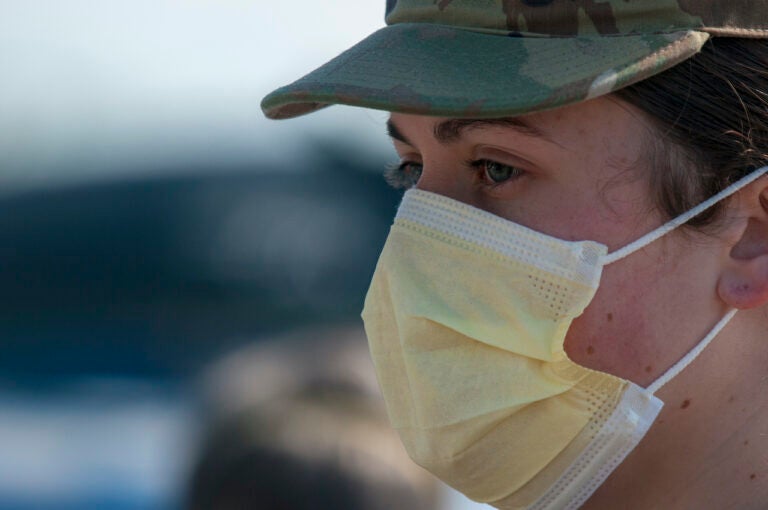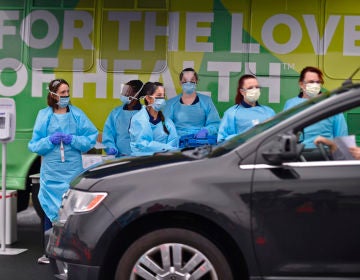Del. coronavirus recovery: Southern case numbers grow as northern region improves
Sussex County is averaging about 40 new cases per day, that’s more than double the rate at the start of October when the county averaged just 15 new cases.

Spc. Kim Whitbeck, a soldier with the Delaware Army National Guard, wears a face mask at the Food Bank of Delaware's drive-thru mobile pantry. (Capt. Brendan Mackie/U.S. Army National Guard)
Delaware has recorded 23,325 total cases of COVID-19 since the start of the pandemic in March. So far, 668 Delawareans have died from coronavirus-related causes. More than half of those deaths, 391, have happened inside long-term care facilities.
“One hundred and seven is a bit concerning,” said Gov. John Carney in his weekly coronavirus briefing. The state is averaging about 132 new cases per day. “Higher than where we want it to be. We want it to be solidly under 100 and we’re flattening out now which is a good thing.”
There are 107 patients being treated for the virus in Delaware hospitals, that’s up 25 since the start of the month and well above the low of 29 recorded in mid-August. “Disproportionately the number of those cases and hospitalizations are coming from the lower part of our state,” he said.
Sussex is averaging about 40 new cases per day, that’s more than double the rate at the start of October when the county averaged just 15 new daily cases.
One result of that increase in southern Delaware is a change in policy for visitors to Beebe Hospital. Patients staying at the hospital are not permitted to have visitors, while patients in the emergency room can be accompanied by just one person. Just last month, the hospital loosened restrictions for visitors, but has now reversed course in response to rising cases.
“Beebe is a safe place to come for care, in part due to the strict safety measures we’ve put into place,” said Beebe president Dr. David Tam. “We do everything possible to stop the spread of the virus.”
Further north, numbers are seeing some improvement. The Newark area near the University of Delaware is seeing an average of just seven new cases per day, down from mid-September when cases were averaging 24 per day.
“The surge that we saw several weeks at the University of Delaware seems to have passed us by,” he said. “Don’t want to spike the ball there, but some really good cooperation there between the University of Delaware, the city of Newark, our teams and public health.”
As the health care industry continues to battle the virus, Carney announced some financial help through $100 million in funding from the federal CARES Act. The Health Care Relief Fund offers aid to home health care agencies, intellectual and developmental disability providers, nursing homes and assisted-living facilities, behavioral health service providers, and Delaware’s hospital systems.
“This Health Care Relief Fund will make sure that Delaware’s health care providers can safely deliver important health care services as we continue to fight this virus,” Carney said. “Delaware’s health care workers have been looking out for the most vulnerable Delawareans since the beginning of this crisis. We owe them our support.”
The grant money can be used for COVID-19 related investments, including technology upgrades, purchases of personal protective equipment, and environmental modifications in health care facilities. The money will also help racial groups and low-income communities in Delaware that have been disproportionately impacted by the virus.
“Some of our low-income and minority communities have borne the brunt of this pandemic,” said Molly Magarik, Secretary of the Delaware Department of Health and Social Services. “That’s why we’re excited to announce an additional $100 million in funding that will support providers and entities to address the gaps and continued need for such resources as telehealth equipment and personal protective equipment.”
There are 590 cases per 10,000 residents among people classified as Hispanic or Latino by the state. The rate for Black residents is at 290 per 10,000, while the rate for white Delawareans is just 137 per 10,000. The death rate is a different story. White residents account for 65% of COVID-19 deaths, Black Delawareans make up 26% of deaths, and Hispanics/Latinos 7%.
WHYY is your source for fact-based, in-depth journalism and information. As a nonprofit organization, we rely on financial support from readers like you. Please give today.




![CoronavirusPandemic_1024x512[1]](https://whyy.org/wp-content/uploads/2020/03/CoronavirusPandemic_1024x5121-300x150.jpg)


